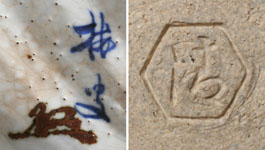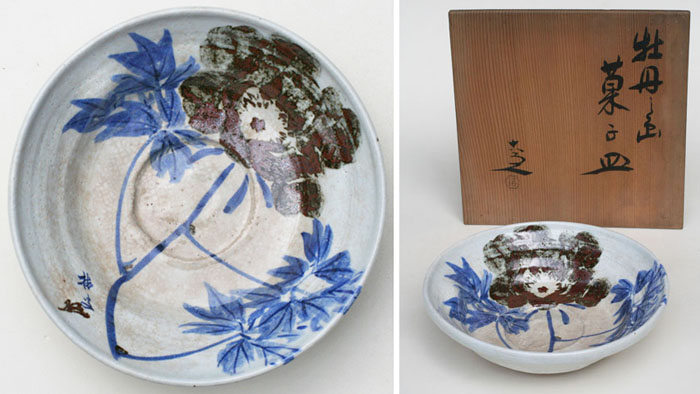Nihonga / Kyôyaki
Kashibachi, bowl for sweets - Botan, peonySigned: Baisô with kaô
Seals: Kiyo
Technique: light grey Kyôyaki with a blue and brown tetsu-e, iron oxide underglaze painting Ø 24 x 7,5
Box: signed by Rokubei
Condition: very good
Box inscription: 牡丹之画 菓子皿 六兵衛「印」清 Bôtan no ga Kashisara [signed:] Rokubei [seal:] Kiyo
On the inside of the lid a worn slip with an explanatory text by Rokubei
Baisô was a pupil of Imao Keinen (1845-1924). He showed at the 3rd Bunten (1909). Founded the Jiyû gadan in 1920 where he showed until 1933. Travelled? to China with Ikeda Keisen, .. .. Shunki and Hayashi Buntô in 1923
The Rokubei family was a dynasty of famous Kyoyaki potters in Kyoto.
Rokubei VI was the eldest son of Rokubei V.
Along with his studies about ceramics under his father Kiyumizu V, he graduated in 1923 in Japanese style painting at the Kyoto Municipal School of Art. In 1927 he started to work with his father. In 1948 he became the 6th head of the family.
During the 1920s and ‘30s Rokubei was one of a prominent group of ceramists in Kyoto, who were considered the first wave of "individualist" potters in contemporary Japanese history and they dominated Kyoto ceramics for half a century .
After he was accepted at the Teiten in 1931 he became a prizewinner in 1934. Rokubei VI consistently pursued techniques of pottery and invented many new methods of glazing and new pot firing methods. He was known for his poetic painting skills. With Kusube Yaichi (1897-1984) Rokubei VI was one of the two leading members of the Nitten (The Japan Fine Arts Exhibition). They helped to promote ceramics from Kyoto by educating a generation of young potters.
Rokubei received the status of Living National Treasure.
“One of the most famous potters of Kyoto in the second half of the 20th century”. (Roberts)
Price: SOLD

